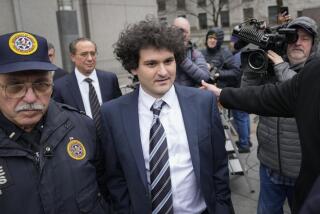Wall Street bailout?
Thornberg and Green conclude this week’s Dust-Up with a debate on the recent Bear Stearns deal. Previously, they discussed the to support federal assistance to borrowers, and the government should facilitate loan modifications to prevent foreclosures.
Preventing a banking system collapse
By Christopher Thornberg
Past housing bubbles had a limit. The bank that loaned the money to the buyer held the mortgage in-house or sold it off to Fannie Mae or Freddie Mac if the mortgage met strict criteria. Given the long-run interest they had in the ability of a buyer to pay back his debt, these bankers were relatively conservative in the choice of who would receive funding. While certain high-risk groups ended up underserved, overall the process worked well to insert a degree of stability into the market.
The current abuses in the mortgage system all started with the new model of how mortgage capital was created through the collateralized debt obligations (CDO) process with investment banks at the helm. Overall, this process is a good one and a model that Fannie and Freddie have been using for years. Instead of raising money through deposits, the investment banks raise capital through the sales of bonds that are linked to the returns on the mortgages. Bond sales inherently are a more stable source of money, as there are no worries about depositors needing their cash back, nor is there a need to keep expensive reserves around. Additionally, bonds could be sold according to a tranche model, where higher tranches would receive their share of proceeds before lower tranches. This is a good way of taking a big batch of risky mortgages and making some safe investment products that the pension funds love and other riskier products that the hedge funds love. Financial alchemy!
The problem with this model, however, is that the investment banks made nice profits on the deals and then walked away they had no long-run stake in the game. As such, the entire incentive system in place was to keep the profit machine running regardless of the clear signs of a massive bubble forming. Bonds continued to be sold regardless of the fact that it was becoming increasingly clear that the mortgages would be unable to pay off the bond buyers.
Now with the bubble popped, there will be massive losses. According to a recent report from Goldman Sachs, the losses on these various bonds could add up to $1.4 trillion, of which we are less than one-seventh of the way through. There is a lot of bad news to come.
Short-run incentives on Wall Street and the problems they can cause for the rest of us are nothing new. You only need to go back to 1999, when the dot-com boom was in full bloom, to see the previous example of the problem. When will we ever learn?
But this time, there is one key difference: Wall Street drank its own Kool-Aid. Big investment banks like Bear Stearns Cos., Citigroup and others not only sold the CDOs they also bought them. And here is the rub: Thanks to the rules that obscure the internal workings of the banks, no one knows who lost what.
Banks make money by borrowing short term and lending long term. It’s a nice model that helps our economy move resources to their best use. However, the system has a basic instability. Because the long lending is inherently less liquid than the short borrowing, such institutions are subject to runs on the bank. Investors, in a panic to avoid potential losses, demand their funding back en masse, trying to get out before everyone else does. Because banks cannot liquidate resources quickly, they can go belly up even if they are financially sound.
This is exactly what happened to Bear Stearns. Investors knew that the bank had large numbers of bad bets on its books, but no one really knows how much. How much is Bear Stearns actually worth? No one knows. It could be liquid, with positive equity value. Then again, it might be functionally bankrupt. Eventually, fear turned to panic and, in investors’ rush to retrieve their funds, the bank was in danger of failure due to a lack of liquidity. The Federal Reserve stepped in to negotiate a takeover by JP Morgan Chase to stem the panic. To overcome JP Morgan’s fear, the Fed guaranteed that it would cover $29 billion in potential losses.
So let’s first dispose of the word “bailout” here. Was the Fed move a bailout? We don’t know. If Bear Stearns turns out to be better off than feared, there will be no payments made by the Fed. If the losses are worse, then we will have a bailout. We just don’t know right now.
Is this the right thing for the Fed to do? Absolutely. Investors who made bad bets should suffer the consequences just like those who bought a house they couldn’t afford. The problem is that if one or two banks go under, the resultant panic could set off numerous bank runs, bringing down not just firms with real losses, but also ones that are fundamentally sound. The bad apples spoil the good ones.
As much as we don’t like the Wall Street billionaires and the CEO tycoons who seemingly walk away from the problems they created, we also have to remember that the financial system provides the necessary liquidity that keeps our economy moving. What is the difference between a recession and a depression? A depression is a recession accompanied by a major failure of the banking system. In the early 1930s, nothing was done to prevent literally thousands of banks from going under, thereby causing untold hardship to millions of people in and out of the financial sector.
The fact is that with a weak U.S. economy and an imploding housing sector, the last thing this nation needs is another meltdown. Are the rich being protected by their own importance? To some extent, yes. But understand that those tycoons lost literally billions of dollars as Bear Stearns stock melted from $170 per share to $10 in the final buyout. They aren’t walking away completely clean, and there are more losses to come and more fortunes to be reduced.
By the time this is over, some taxpayer dollars are going to be spent and some culprits will not face the full financial wrath of the problems they created. But we must be pragmatic and understand that no one benefits if the banking system completely melts down. We can only hope that this crisis will foster proper regulation to prevent such future abuses.
Christopher Thornberg is a founding partner with Beacon Economics.
If banks deserve help, so do ordinary Americans
By Ginna Green
Chris, you’re absolutely right: This is not your mother’s mortgage market.
When my parents purchased their first home, it was after saving for a few years, from a local lender and only after vigorous and responsible underwriting that determined that they an attorney and an engineer could indeed afford the home they were purchasing and understood the features and terms of their mortgage. Of course, it was in the lender’s best interest too to verify my parents’ income and ensure that they understood this monumental transaction. After all, if Mom and Dad defaulted, our good ol’ neighborhood bank would be the one left holding the bag.
But that’s no longer the case, with Wall Street packaging and slicing and dicing sub-prime mortgages for the benefit of its investors, as you explained in great detail. And you also hit on the premier problem of the sub-prime mortgage fiasco: “This is a good way of taking a big batch of risky mortgages and making some safe investment products that the pension funds love and other riskier products that the hedge funds love.”
How did we get to the point where risky mortgages arguably the single most important and complex transaction most American families will ever make are an acceptable option for millions of homeowners? If Wall Street says it’s good, then it must be good enough Main Street?
Apparently, nothing could be further from the truth, with more than 2 million American families with unfair, deceptive home loans facing foreclosure over the next two to three years. These loans, risky as they were, weren’t good for borrowers and, as it turns out, weren’t good for investors or the domestic and global economies either.
As a result, the Fed has been trying repeatedly since September to contain the foreclosure crisis that’s spreading rapidly to the general economy. It has lowered key interest rates a half a dozen times, and, to quote The Wall Street Journal, “undertaken the broadest expansions of its lending authority since the 1930s.” But there’s no doubt that jaws dropped two weeks ago when the Fed orchestrated its bailout of Bear Stearns, one of the main financial firms responsible for causing this mortgage mess in the first place.
Of course, in keeping Bear Stearns solvent, the Fed hoped to avert a domino effect that could engender a widespread market meltdown, which no one wants. But if a firm that’s partially to blame for this crisis warrants assistance, then no doubt so do millions of ordinary Americans who are struggling to keep their homes. Ordinary Americans who could have qualified for prime loans with reasonable rates and terms. Ordinary Americans who mistakenly thought that their mortgage brokers had their best interests in mind, only to find that their brokers in a lovely trickle-down effect got paid more for bringing in risky loans than for solid ones. Let’s not forget the words of former Ownit Mortgage Solutions chief executive William Dallas: “The market is paying me to do a no-income-verification loan more than it is paying me to do the full documentation loans. What would you do?”
While we watch millions of American families lose their homes, stability and wealth, we must also note that their neighbors are at risk too, with plummeting property values totaling $350 billion nationwide as a result of mass foreclosures. Communities will see tax bases erode further.
For the common good, federal officials need to act fast (one quick way is to tweak bankruptcy laws) to find solutions for working families and neighborhoods. This time, what’s good for Main Street is good for Wall Street: Averting foreclosures would not only help families and neighborhoods, but would also benefit the market by avoiding further losses to lenders and investors.
Consumer spending accounts for 70% of economic activity in this country. As such, individuals are the backbone of the country’s economic well-being, just as much as or more so than Wall Street lenders and investors. If Bear Stearns got help from the Fed, don’t hard-working Americans deserve it too?
Ginna Green is a spokesperson for the Center for Responsible Lending.
| | | Day 4
More to Read
Inside the business of entertainment
The Wide Shot brings you news, analysis and insights on everything from streaming wars to production — and what it all means for the future.
You may occasionally receive promotional content from the Los Angeles Times.










